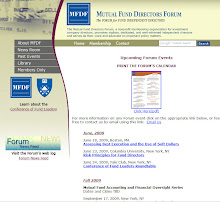Director of the SEC's Division of Trading and Markets, Erik Sirri's, opening remarks before the Commission's December 3 open meeting provide an excellent summary of the Commission's actions to strengthen regulation of credit rating agencies, known as "NRSRO's."
The rules adopted on December 3 also add three new prohibited conflicts to Rule 17g-5(c):
The full text of Mr. Sirri's opening remarks is available at: http://www.sec.gov/news/speech/2008/spch120308ers.htm
The full texts of the final and proposing releases will be availalble shortly on the SEC's website.
The recommended rules are designed to promote the substantive goals of the Credit Rating Agency Reform Act of 2006 — to increase transparency and disclosure, to diminish or eliminate conflicts of interest, and to strengthen the oversight of NRSROs.At the open meeting, the Commission adopted final rules, proposed in June of 2008, that increase reporting requirements for NRSROs regarding their internal assessments and processes to allow users of credit ratings to gain a better understanding of the methods employed by the NRSROs to determine and monitor credit ratings. Under these new rules, NRSROs will be required to disclose:
- whether and, if so, how much verification performed on assets underlying or referenced by a structured finance transaction is relied on in determining credit ratings;
- whether and, if so, how assessments of the quality of originators of structured finance transactions play a part in the determination of the credit ratings; and
- the frequency of its surveillance efforts and how changes to its quantitative and qualitative ratings models are incorporated into the surveillance process.
The rules adopted on December 3 also add three new prohibited conflicts to Rule 17g-5(c):
- The first amendment prohibits an NRSRO from issuing a credit rating with respect to an obligor or security where the NRSRO or a person associated with the NRSRO made recommendations to the obligor or the issuer, underwriter, or sponsor of the security about the corporate or legal structure, assets, liabilities, or activities of the obligor or issuer of the security. This amendment, in effect, would prohibit an NRSRO from rating its own work.
- The second amendment prohibits a person within an NRSRO who has responsibility for participating in determining credit ratings or for developing or approving procedures or methods used for determining credit ratings from participating in any fee discussions, negotiations, or arrangements. The purpose of this amendment is to remove the persons most directly involved in making the judgments that credit ratings are based on from fee negotiations and, thereby, insulate them from a process that could make them more or less favorably disposed toward a client or class of clients.
- The third amendment would prohibit NRSRO personnel who participated in determining or monitoring a credit rating from receiving gifts, including entertainment, from the obligor being rated, or from the issuer, underwriter, or sponsor of the securities being rated, other than items provided in the context of normal business activities such as meetings that have an aggregate value of no more than $25. The purpose of this rule is to eliminate the potential undue influence that gifts can have on those responsible for determining credit ratings.
The purpose of this proposed amendment is to provide users of credit ratings, investors, and other market participants and observers with the maximum amount of raw data with which to compare how NRSROs initially rated an obligor or security and, subsequently, adjusted those ratings, including the timing of the adjustments. The Commission believes that requiring the disclosure of the ratings action history of each issuer-paid credit rating would create the opportunity for market participants to use the information to develop performance measurement statistics that would supplement those required to be published by the NRSROs themselves in Exhibit 1 to Form NRSRO.
The full text of Mr. Sirri's opening remarks is available at: http://www.sec.gov/news/speech/2008/spch120308ers.htm
The full texts of the final and proposing releases will be availalble shortly on the SEC's website.





